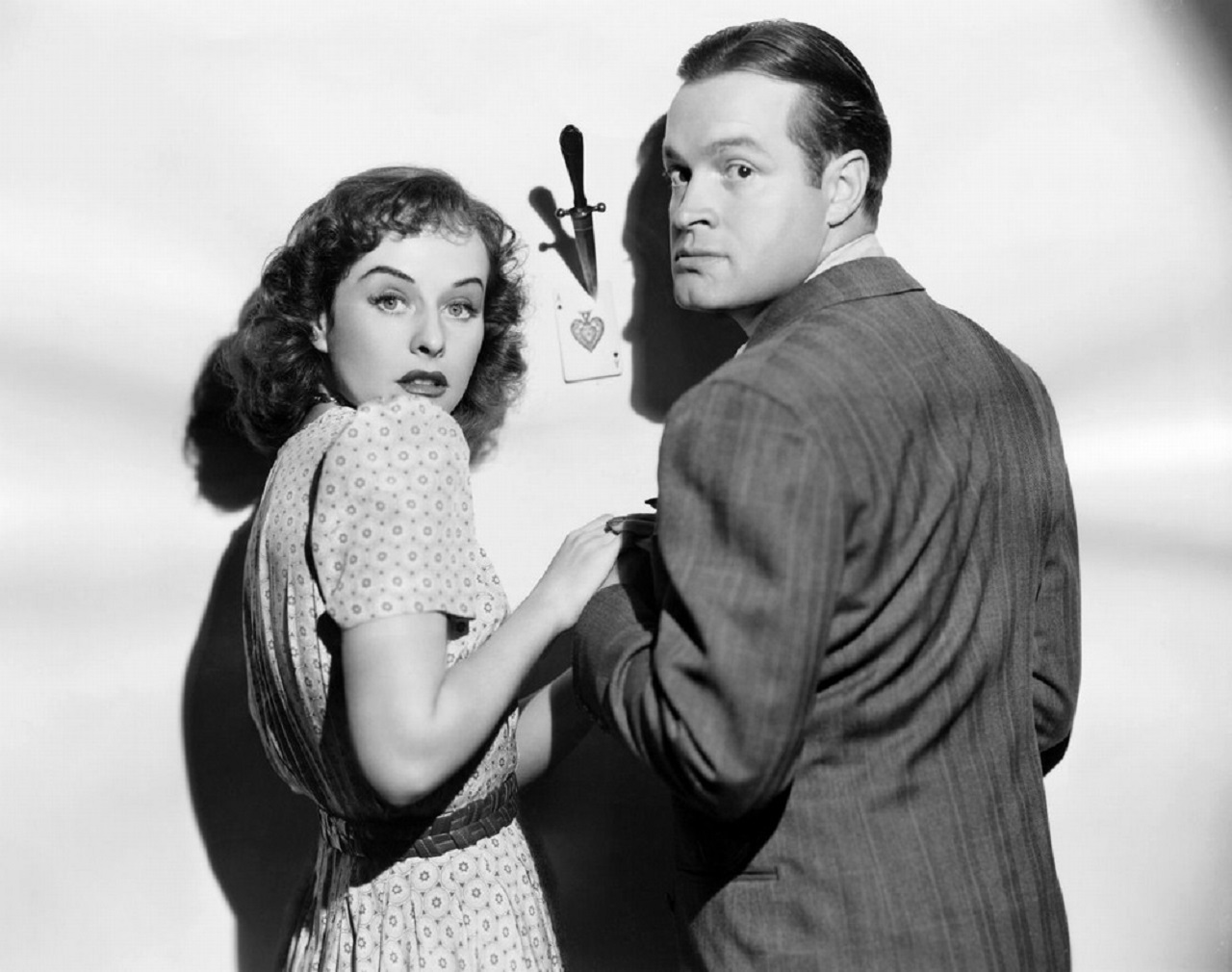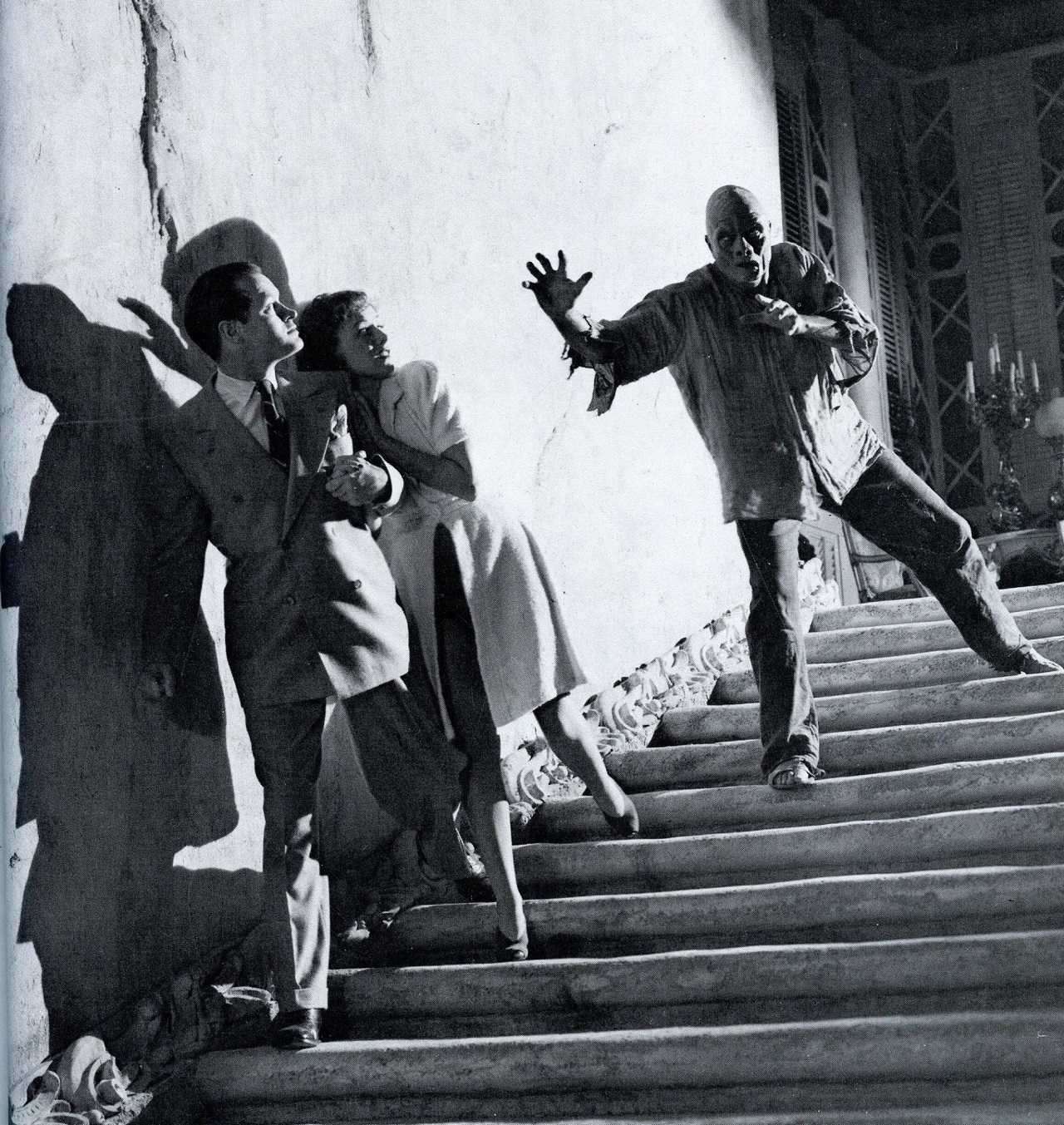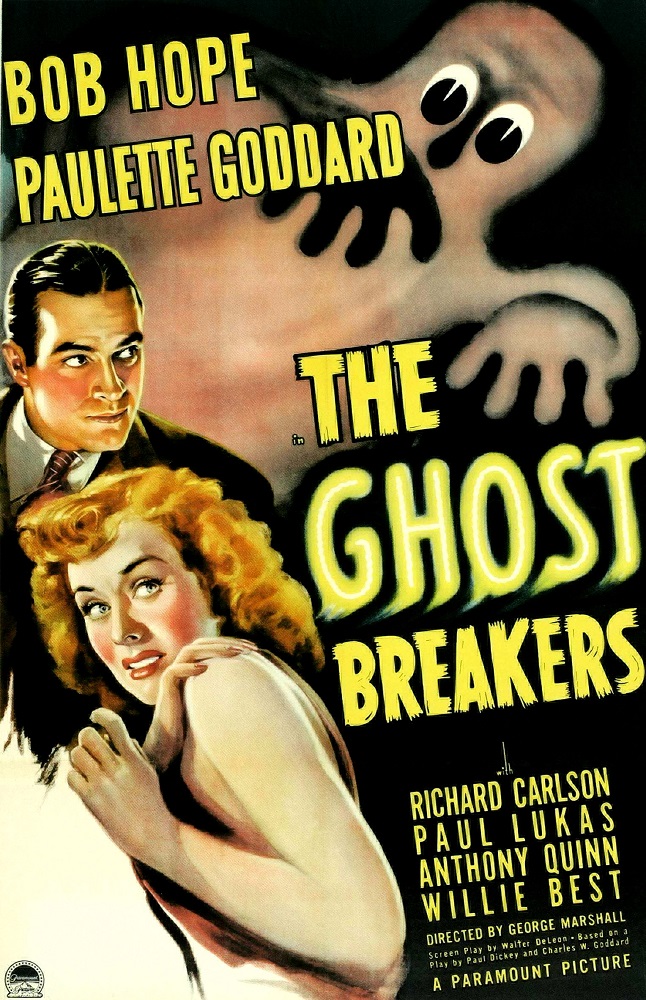Crew
Director – George Marshall, Screenplay – Walter DeLeon, Based on the Play by Paul Dickey & Charles W. Goddard, Producer – Arthur Hornblow, Jr., Photography (b&w) – Charles Lang, Music – Ernst Toch, Process Photography – Farciot Edouart, Art Direction – Hans Dreier & Robert Usher. Production Company – Paramount.
Cast
Bob Hope (Larry Lawrence), Paulette Goddard (Mary Carter), Willie Best (Alex), Paul Lukas (Parada), Richard Carlson (Geoff Montgomery), Pedro De Cordoba (Havez), Anthony Quinn (Ramon Mederos/Francisco Mederos), Tom Dugan (Raspy Kelly), Paul Fix (Frenchy Duval), Noble Johnson (The Zombie), Virginia Brissac (Mother Zombie)
Plot
In New York City, Mary Carter learns that she has inherited the reputedly haunted castle Castillo Maldito on Black Island in Cuba. Immediately after, she receives offers from people wanting to buy the property from her. At the same time, radio broadcaster Larry Lawrence is called to a meeting with mobster Frenchy Duval after making fun of him on one of his shows. Fearing that he is going to be shot, Larry’s manservant gives him a gun. In the hall, Larry jumps and the gun goes off just as another man is shot. Thinking he has killed the man, Larry takes refuge in Mary’s room. As the police search the hotel, he hides in her trunk and is unwittingly packed up and put on the boat to Cuba. Aboard the ship, he tries to protect her from various peoples determined to obtain the castle. On Black Island, they set out to confront the ghosts, zombies and other sinister parties that are skulking around the castle.
The Old Dark House Film was a popular genre during the 1920s. Emerging from the success of various Broadway plays, there were numerous films in the silent era such as The Unholy Three (1925), The Bat (1926), the hugely popular and influential The Cat and the Canary (1927), The Gorilla (1927), The Unknown Terror (1927) and The Terror (1928). These usually featured heroines/heiresses in old dark houses facing menacing criminals who were disguised as some kind of maniac named after an animal, and would combine thrills, some scary elements and an absurdly improbable whodunnit ending.
A newfound lease of life was found on the Old Dark House film in the sound era with the remake of The Cat and the Canary (1939), which cast Paulette Goddard as the imperilled heiress and added Bob Hope as the comic star of the show and turned the original into a comedy.
The success of The Cat and the Canary ushered in a new era of Old Dark House films that were played for laughs. Most of the screen comics of the era played in at least one of these, including the likes of The Ritz Brothers in a remake of The Gorilla (1939), big band leader Kay Kyser in You’ll Find Out (1940), Abbott and Costello in Hold That Ghost (1941), Laurel and Hardy in A-Haunting We Will Go (1942), as well as the East Side Kids/Bowery Boys who made no less than five ventures into the genre including the likes of Spooks Run Wild (1941) and Ghosts on the Loose (1943).

Flush from the success of The Cat and the Canary, Bob Hope and Paulette Goddard were re-paired again here in what is all but a sequel. In this case, the producers turned to The Ghost Breaker (1909), a play by Paul Dickey and Charles W. Goddard. This had been filmed twice before as The Ghost Breaker (1914) starring H.B. Warner and co-directed by no less than Cecil B. DeMille, and The Ghost Breaker (1922). Hope and Goddard essentially go through the same plot of The Cat and the Canary again – she is the heiress, he the wisecracking comedy star – as they make their way through a big creaky old mansions filled with ghosts (that are mostly mundane in explanation), sinister parties seeking to eliminate the heiress and much skulduggery and comic antics.
The Ghost Breakers is slightly more fantastical than The Cat and the Canary was – there is one genuine ghostly apparition where we see the ghost of the slaver rise from out of a chest, while there is also a minor element involving voodoo and a lurking zombie. (This makes it one of the few Old Dark House films of the era in which the ghost/supernatural elements were real as opposed to rationalised away at the end). This also makes The Ghost Breakers much better in terms of atmosphere than the prosaic job that Elliot Nugent did on The Cat and the Canary – the interior of the house (which keeps getting referred to as a castle but looks like a massive-sized mansion) being a particular standout job in terms of production design.
The film is lifted considerably by Bob Hope, tossing off a barrage of one-liners with great comic timing. With Hope on top form, director George Marshall keeps the film snappy and fast paced. This results in some wonderfully goofy and nonsensical scenes – Bob Hope getting out of the trunk and staggering around the cabin hunched over at the waist; a wonderfully ridiculous scene where Willie Best tries to explain away Hope’s voice coming from inside the trunk to various passers-by including a drunk. There are more of the political jibes that there were in the first film: “A zombie has no will of his own. You see them sometimes walking around blindly with dead eyes, following orders, not knowing what they do, not caring” to which Hope replies: “You mean like Democrats?”

As with many of the films of the era, there is a racist element that kind of takes you aback today. Bob Hope comes with a Black manservant played by Willie Best, a popular comic player in films of this period. Hope is constantly making comments like: “You look like a Black out in a blackout … this keeps up and I’ll have to paint you white.” As with the characterisation preferred for almost any African-American actor cast in a comedy, Best is only required to play stupid and afraid. The Cubans we see throughout (a pre-Castro Cuba too, one should add, back in the period when the country was seen as American-friendly) don’t get off too much better – most of their accents end up making them sound like Bela Lugosi.
The film was later remade as Scared Stiff (1953), also from the same director George Marshall, with the Bob Hope and Paulette Goddard roles being recast with Jerry Lewis and Dean Martin.
Director George Marshall (1891-1975) was a prolific director principally of comedies and some Westerns. These include classic works such as Destry Rides Again (1939), You Can’t Cheat an Honest Man (1939), The Blue Dahlia (1946), The Perils of Pauline (1947) and Houdini (1953), although no other genre vehicles.
Trailer here


